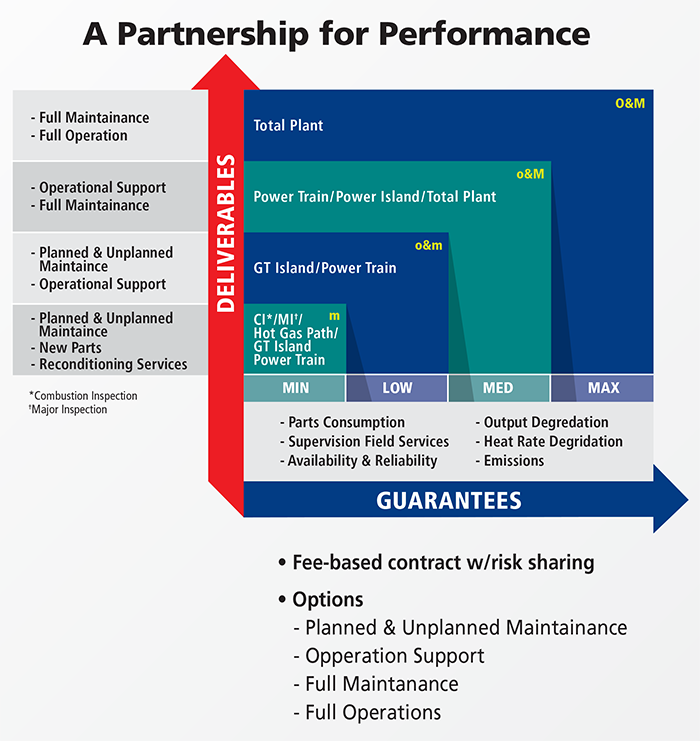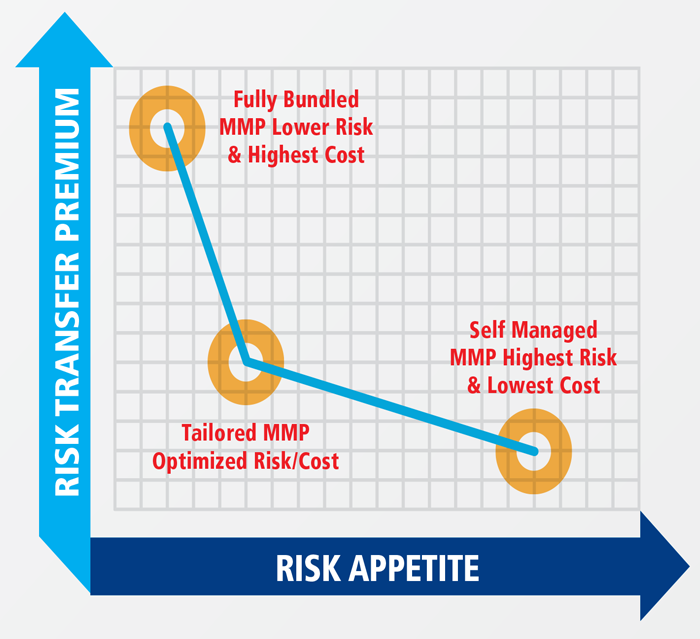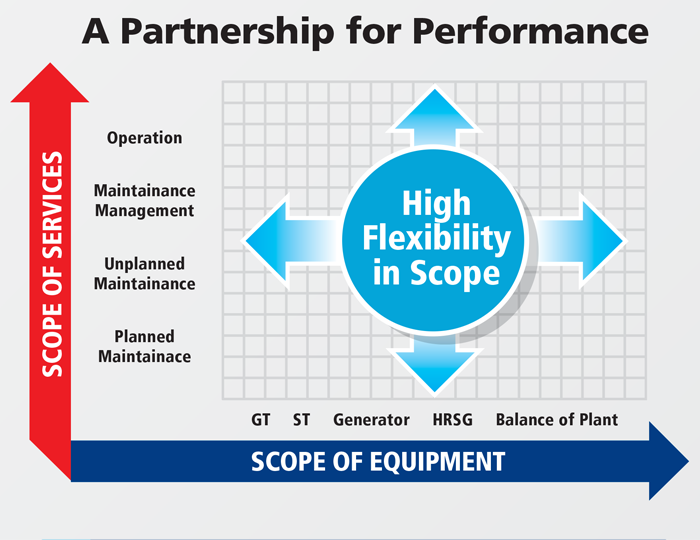The need:
The need for reliable, flexible and competitive power generation has never been greater. One of the biggest barriers to remaining reliable and competitive in volatile energy markets is to have an optimum maintenance program for complex combustion turbine power generating assets. This is particularly true for matured technology – E and F class machines.
VALUE PROPOSITION
STPS has developed alternative MMPs that are relevant to the current energy market while comfortably delivering life-cycle cost savings of 35% or more along with …
- Predictable and Optimized Maintenance Costs,
- Speedy access to parts and services for planned and unplanned maintenance,
- Reduced risk of prolonged maintenance outage.
ST Power Services offers a comprehensive assessment product that evaluates the client’s existing MMP by comparing the life cycle cost of the current maintenance strategy with the life cycle cost of an alternative maintenance strategy that considers the relevant market conditions and current market price.
Costs, risk and implementation strategies are provided for transitioning from the existing MMP to a pragmatic and cost-effective alternative.
Product deliverables are tailored specifically to the client’s need, risk appetite, asset operating profile, market dynamics and spare parts inventory.
Benefits to the Power Plant Owner include:
- Predictable and Optimized Maintenance Costs,
- Speedy access to parts and services for planned and unplanned maintenance,
- Reduced risk of prolonged maintenance outages.
MMP life cycle savings of 35% or more are often realized through this assessment and optimization process.
Typical product deliverables include:
- Baseline life-cycle cost of the existing MMP by developing a long-term cash flow model (nominal and real dollar based) and by estimating cumulative MMP life cycle costs savings over the planning horizon (typically 25 years).
- Assessment of existing MMP relative to;
- Outage execution services,
- Capital parts exchange scenarios – refurbishment including fall-out, end-of-life replacements, parts design and performance upgrades, remaining operating life, and end of MMP term residual capital parts value,
- Structural component provisions – rotor life time assessment, combustor housing, turbine casings, exhaust gas housing, etc.,
- Evaluate MMP contract scope, term, termination options and costs, and extra work provisions.
- Assess spare parts inventory levels and fleet inventory restrictions, such as restrictions to plant use, lender collateral restrictions, regulatory accounting restrictions or other factors impacting the sharing of spares across the client fleet.
- Develop minimum inventory of critical parts that would support planned and unplanned outages while reducing inventory carrying costs and working capital cost and increasing inventory turns. Surplus and obsolete inventory monetization plans and options are addressed.
- Assess aftermarket MMP alternatives using the same planning horizon and scope of services covered under existing MMP program and develop a life cycle cash flow model considering indicative pricing from qualified aftermarket parts and service providers.
- MMP solutions range from a fully bundled program with a single provider to a self-managed transactional program.
- The purpose of strong fully bundled MMP is to transfer risk of planned maintenance through a contractual relationship between a Power Plant Owner, Operations & Maintenance team and aftermarket Service Provider over a defined term in which a Service Provider commits to providing parts and services at a (relatively) fixed price over the term of the agreement. These parts and services should also (by best practice standards) include performance guarantees.
- Self-managed programs position the client as the program manager with specific scope contracted separately to outage service providers, parts providers, and parts repair service providers to generate the least cost MMP.

- The optimum MMP considers client risk appetite, willingness to transfer program risk to another party and Operations & Maintenance strategy to design a tailored solution that best fits the client’s business objectives.

- Develop a transition strategy, cost, timeline and resource requirements to transition from the current MMP to a new optimal MMP.
- To the extent applicable, MMP bid process may be presented to include;
- Technical and commercial scope development,
- Recommended list of invited bidders,
- Bid preparation, delivery, and clarifications,
- Bid review, assessment, and rankings,
- Commercial contract negotiations.
- New MMP implementation includes;
- Resource requirements,
- Parts tracking models,
- Outage projection models,
- Inventory optimization,
- Capital parts life cycle management models,
- Payback analysis.
- ST Power Services offers Program Management services to support new MMP transition, implementation, and ongoing management.
- Alternatively, for Self-Managed MMPs, ST Power Services will provide;
- Interim Program Management,
- O&M and Asset Management personnel training,
- Computer models for O&M personnel to be self-sufficient in Program Management.
- The ST Power Services team has extensive experience developing and implementing self-managed MMPs.
- ST Power Services’ team supports client;
- Business case development,
- Financial model stress test,
- Develop economic, financial and risk presentations for senior management, board of directors, lenders, lender engineers, shareholders, debt rating agencies, property insurance providers and other key stakeholders involved in the business strategy decision and approvals.
- ST Power Services applies a pragmatic approach to developing an MMP framework tailored to your power plant’s needs. Specifically we provide;
- A Flexible MMP Structure,
- Maintenance strategy,
- Start based / Operating hour based / both,
- Planned and unplanned maintenance, routine maintenance, CBM (Condition Based Maintenance) assessment.

- Technical Scope;
- Covered equipment,
- Inspect only equipment (structural equipment),
- Parts and Services for planned and unplanned maintenance.
- A Flexible MMP Structure,
BACKGROUND: "State of the Power Generation Industry"
- The power generation industry faces a daunting challenge of producing reliable energy to meet growing demands. Energy market studies suggest that by 2030, electricity use will double globally and triple in developing countries.
- Influx of renewable generation capacity is adversely affecting capacity factors, profitability and energy margins of traditional combined cycle units.
- The daunting challenge for combustion turbine owners is to maintain the strong viability of their power generating assets to compete in shifting market conditions and to create stakeholder value.
- Asset viability depends on a robust maintenance program, which is a significant cost component in the plant budget. Since plant profitability has been adversely affected by shifting market conditions, life cycle cost reduction and a robust maintenance program are key factors to remaining competitive and enhancing plant profitability.
- It is imperative for owners to have a trained and knowledgeable Operation and Maintenance (O&M) team to compliment the Service Provider’s expertise. This is due to the decrease in readily available critical parts and services to efficiently operate and maintain legacy assets.
- Original Equipment Manufacturers (OEM) and aftermarket services providers offer MMP for mature technology E and F class machines, which include attractively priced capital parts, repairs, and outage services.
- Lenders, Lender’s engineers, asset insurers, and debt rating agencies have accepted the risk profile in both OEM and aftermarket MMP offers for matured technology.
- In recent years, a growing presence of aftermarket service providers for mature technology has caused the market price for capital parts and repairs to significantly decline.
- Many combustion turbine owners have parts, repairs, and service contracts that do not reflect the current market price. In most cases, Owners are paying significantly higher prices because they are locked into outdated service contracts that are based on invalid assumptions for current market conditions.
- Support for client’s accounting requirements through technical assessment of MMP sub component costs and categorization for seamless integration into their accounting system.
- Recommend optimum MMP based on cash flow, risk profile, market dynamics, and overall business objectives.

35%
or more are often realized through this assessment & optimization process.
Advantages
Performance Guarantees
- Availability
- Starting & Operating Reliability
- Operating flexibility – minimum load reduction, fast startup
- Response time
- Outage duration
Financial & Commercial
- Fees, milestone payments
- Cash flow
- Payment terms
- Escalation
- Termination Provisions & Market Competitive Test
- Term
Evaluation Process
- Adherence to need / requirements
- Economics / ROI / Cost-benefit analysis
- Capabilities of Service Provider / Value proposition
- Technical & Commercial risk assessment

